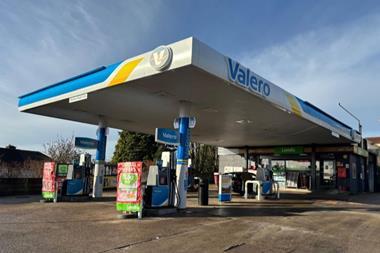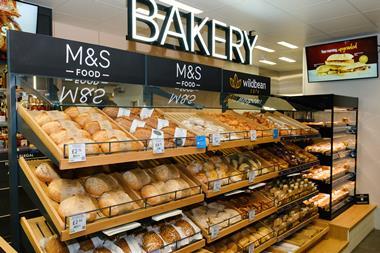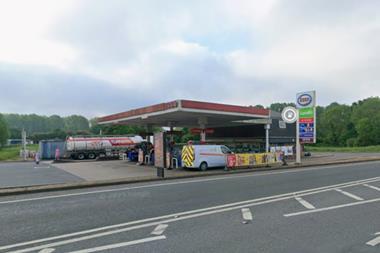While a cash machine is fast becoming an expected facility on the forecourt, many motorists remain oblivious to the availability of the service at petrol stations.
According to Harris International Marketing’s Convenience Tracking Programme, an automated teller machine (ATM) can really drive footfall and incremental sales with the service being top of the list of consumers’ expectations. But, says HIM’s managing director Tom Fender, communication is vital if retailers are going to make the most of the benefits a cash machine can bring.
“Large proportions of shoppers at stores with an ATM still don’t know there is an ATM in the store,” says Fender. “Signage, internal and external, must be simple, bold and effective.
“Only about 25-45 per cent of shoppers use the ATM in a typical month, but higher awareness leads to higher usage,” he adds.
Not only do ATM users visit forecourts more frequently – an average of four times per week compared to 3.7 times a week by the average c-shopper – they also spend more per trip. According to HIM, ATM users spend £5.11 in the forecourt shop per trip compared to £3.83 – that’s 65 per cent more per week at £13.80 versus £8.36.
“Consumers are buying 3.1 items per visit on average with confectionery, milk and news top of the list,” says Fender.
A Hanco cash machine has helped fuel a business boom for Caenby Corner Garage in Lincoln, which is enjoying increased profits and attracting dozens of new customers.
Owner Geoff Steel’s decision to purchase a Hanco ATM has prompted up to 350 transactions a week, an increase in profits and a host of new faces visiting the site to withdraw cash.
“We are a petrol station and convenience store and for many years have relied on the same customers who we regarded as regulars,” says Steel. “Things were going well but we wanted to expand the business and increase our customer base. Our aim was to attract more motorists who would want the convenience of getting their petrol with us and then be able to withdraw money from the cash machine. We also wanted more passers-by who did not necessarily need petrol but wanted to get money to buy something from the shop.
“Since we got the machine that’s exactly what has happened – in fact it has exceeded our expectations.”
The in-store machines takes up three square feet of floor space and requires a power socket and BT phone line. They are self-fill using money from the till, so a retailer only needs to put in as much money as necessary.
“Everyone can benefit from getting a cash machine – it’s a two-way thing, Steel adds. “We’re happy but it’s equally beneficial for customers – it’s convenient for them and is a popular facility. The most important thing is always the customer and for us to offer what they want – whether that’s petrol, items in the shop or other facilities. The Hanco cash machine fits into that category and the demand highlights just how important it’s become.”
Todd Hannon, Hanco’s managing director, says: “Cash machines can lead to increased profits and help add to a retailer’s customers base, which is what has happened at Caenby Corner Garage. But importantly they also offer convenience and choice to customers who may want to withdraw money at a time and location to fit in with their lifestyle demands.
“We are increasing our presence in the forecourt sector as petrol stations provide a vital service where customers want access to an increasingly diverse range of facilities.”
SELF FILL OR CASH IN TRANSIT
There’s currently around 25 per cent penetration of ATMs in forecourts, and the vast majority are through-the-wall machines supplied by banks.
Cash machines such as Hanco’s at Caenby Garage operate on a surcharge basis, and the retailer is responsible for filling the machine with cash each day. With these merchant-fill machines, the retailer is able to control the surcharge level. He or she, in theory, can set the fee as high or low as they wish.
“That puts the retailer in control of their own destiny,” says Hannon. “The break-even point if you’re not surcharging is much higher. A retailer might need to do £5,000 to £6,000 a month in transactions to break even.”
He adds: “A lot of retailers don’t understand what’s involved with a merchant-fill machine. They envisage armoured vehicles and so on. But in reality the retailer sets the cash level against sales performance so if they monitor and record cash machine transactions, the cash level can mirror trading patterns.
“Most forecourts have a significant amount of cash going through them, so operating an ATM is a good way of getting that cash out.” But a big problem, says Hannon, is that the machine can run out of cash in a merchant-fill scenario because the retailer fails to fill it up regularly.
“If you use a cash in transit (CIT) machine, however, you have the added cost of filling it up. With merchant-fill, the retailer is recycling their own cash and making a fee on top of it.”
Filling issues aside, Hannon at Hanco believes an internal ATM is more effective in driving footfall.
“Because an external ATM has to be located away from the flow of traffic, 95 per cent of customers using a through-the-wall cash machine never spend a penny on the forecourt, not even on petrol,” he says.
“An average of 10 per cent of the money from an internal ATM is spent back into the business. So, if the average transaction is £40, £4 of that will be spent inside the shop. The internal ATM will bring the customer in and give them cash, which can then be put back into the store.”
Hanco also insists that an internal cash machine is a more secure way of operating an ATM for forecourts.
“Merchant-fill provides a more secure environment because you’re only keeping a few thousand pounds at any one time and it is emptied just as with the cash register,” says Barnes.
“You keep less cash in the machine and empty it at the end of the day. Most forecourts are glass fronted so if the machine is left wide open when it is emptied, it will be blatantly obvious there’s no money to be stolen.
“The retailer just needs to pull the cash box out – they’re not opening and loading in front of the ATM. We need to get the image out of people’s minds that bags and bags of cash are being loaded.”
Barnes says retailers can help this situation by managing the cash sensibly, just as they do elsewhere in the store. “The retailer should fill it to an appropriate level so they don’t have a few thousand pounds left at the end of the day. It should be operated like bringing up the cash register at the beginning of the day,” he says.
AWARENESS
The biggest challenge, says Hanco, is letting customers know that a cash point is available in the first place.
“No matter how many posters you put up, the majority of customers are not aware that an ATM is on the forecourt,” says Barnes. “The pole sign is a waste of time because customers only look for price. It’s also in corporate colours so other messages just blend in. Customers will take more notice of a separate sign for the ATM.”
Fuelforce believes it has the answer to the awareness issue. It has rolled out a new pod style of ATM at 70 sites in its 170-strong network.
Steve Walton, marketing controller at Fuelforce, says: “Our original plan was to have hole-in-the-wall ATMs as we believe they drive greater footfall.
“The downside is they take construction alterations for the building and can
steal retail or storage space. Planning permission is also needed.
“Travelex is our ATM partner and came up with the pod cash machines. The pod is still located externally so had all those benefits, but it is also more imposing so consumers are more aware that an ATM exists on the forecourt.
More presence will also drive increased usage – it’s a double benefit.
“There was no need to make any building alterations because it’s just bolted on. This also meant we were able to install more machines quicker – it really accelerated the rollout programme. It has taken about one year to install 70 pods.”
Fuelforce surveyed every site to evaluate suitability for an external ATM. A building company assessment also established whether any building works were necessary.
“Some sites needed slight building modifications such as installing a kerb, bricking up a window, installing a power supply – all low-key stuff. Machines were ordered and supplied in nine months.”
Fuelforce has been working on the project for over two years and has traded with four different cash point companies in that time.
“Travelex came up with the solution which best fitted our requirements,” explains Walton.
“Our goal is to have a cash facility available to customers on all sites. Around 60-70 per cent will be the external pods, and 25 per cent internal ATMs, where usage is lower so requires a lower-cost unit.
“An internal unit takes fewer transactions to pay it off. There is also a small number of locations where we don’t believe there is a requirement for any cash machine.”
The Travelex pods are replenished by cash handler Brinks.
“Brinks monitors levels of cash and replenishes as required – we have no involvement in the replenishment,” says Walton.
“One of the evaluations was that we wanted site staff to concentrate on the site business and not worry about cash levels in the ATM.”
An ATM customer will evidently be a repeat customer once you get them on the site. The average user of an ATM uses it three times per week so it helps to make the forecourt a destination site .
“While there is a difference between transient and local sites, a cash machine can help to build on loyalty and repeat visits,” says Hannon.
“But if it’s consistently out of cash, they won’t come back. Two strikes and you’re out. Then you’ve got a lost ATM customer and a lost store customer. You’re giving the customer cash to buy other merchandise – not a lot of other products will do that.
“As more ATMs come into the market, consumer expectation will increase,” he concludes. “A retailer is at a competitive disadvantage if they don’t have an ATM.”



























No comments yet